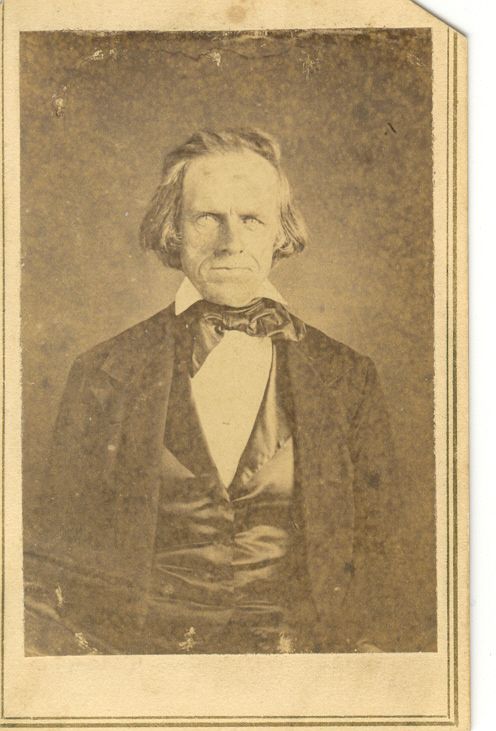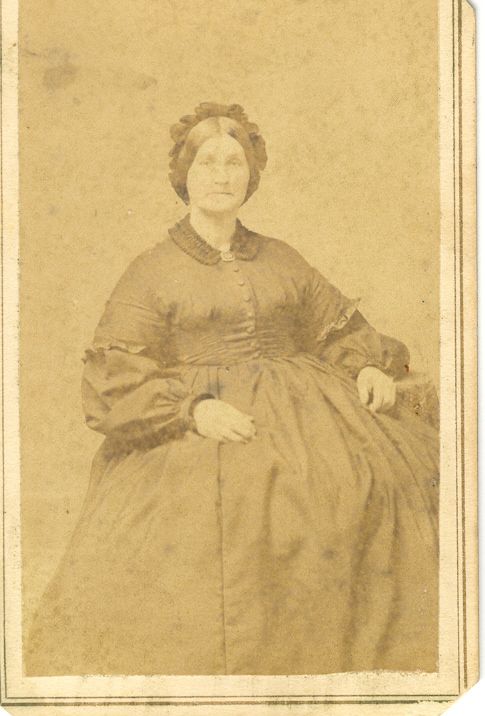 Hello. My name is Ardis. I am a research addict.
Hello. My name is Ardis. I am a research addict.
It all started on a fall evening in 1986, and it’s the fault of the gentleman whose picture you see here – John Saunders (1805-1860). Yeah, that’s him. Take a close look. He looks a little odd because his eyes were blue, and blue did not register in the photography of his day. At least he combed his hair before he sat for his portrait, which is more than you can say for his contemporary, Abraham Lincoln.
My father had been interested in family history, or at least the photographs of family members, from the time he was child in Rochester, New York. He collected family pictures beginning in the 1920s and ‘30s, when there were still aunts and uncles around who could identify the Civil War generation, and a few even older. When he joined the Church in 1964, he dabbled a bit in organizing data about his ancestors preparatory to temple ordinances, but his primary interest remained centered on his huge family photograph collection.
 Because Dad was himself a photographer, he made copies of his pictures and stored the originals carefully away. Some kids grow up with Sesame Street flashcards; I grew up with my own copies of the portraits of ancestors, learning to distinguish one stern face from another.
Because Dad was himself a photographer, he made copies of his pictures and stored the originals carefully away. Some kids grow up with Sesame Street flashcards; I grew up with my own copies of the portraits of ancestors, learning to distinguish one stern face from another.
But there was one couple Dad could not identify – this man, and his wife, also shown here. He knew they were the parents of Ann Saunders Parshall, but he did not know their names. So for me, too, they remained mysterious – “the scary man who wasn’t really scary (it was only his blue eyes that made him look that way), and his wife.”
Flash forward to 1986, a few days before that fateful fall evening. I was living and working in Provo, trying to get back into school post-mission. Dad called me as excited as I had ever heard him. For the first time in who knows how many years, he had been handling his original portraits, and there on the backs of these two, written as plain as day, were the names “John Saunders” and “Nancy Gage Saunders.” Who knew how those inscriptions had been overlooked for so long? But there they were, and there was Dad on the phone, sounding as though he had just won the lottery.
He was so pleased that I decided to see if I could learn something about this couple by going to the genealogical library. I knew there was one on the fourth floor of the BYU library, although I had never used it, so off I went one evening after work.
I was so green then that I didn’t even know that the genealogical library had a separate catalog from the regular BYU library catalog. I was also so afraid of looking like I didn’t belong there that I didn’t dare ask anybody for help. So I bluffed. I walked in, trying to look as if I knew what I was doing.
Okay, everybody seems to be using microfilms, and getting them from those cabinets over there. So in order to cover my ignorance, I opened a random drawer and drew out a random microfilm. There. Now nobody would know I didn’t know how to figure out which microfilm I needed.
Next I walked over to a microfilm reader and saw that there was a diagram showing how to thread the film. Good. I could fiddle with putting my film on the machine while I looked around at what everybody else was doing to figure out how you did this genealogy stuff. Fiddle … fiddle … fiddle … there, the film was on.
I cranked the machine handle, like everybody else was doing. They would crank for a moment, then look down at the screen, then crank some more, and look down again. So I cranked a while, then looked down like they did. And there on the screen I read these words:
John Saunders, a farmer of Yates County, married Nancy Gage, daughter of Amasa Gage of Gorham, Ontario County.
The film I had taken out of the drawer was a collection of New York county histories; the random page where I had stopped cranking was from a history of Yates County, where my family had lived for six generations.
That’s all it took. I was instantly hooked. For the next two years, I worked every evening, every Saturday, and two Sundays a month (they were closed the other two Sundays) until they kicked me out at night playing those obnoxiously loud march tunes over the loudspeaker. During lunch hours and odd moments at work every day, I would type up my finds from the night before. And every morning before work, I would file and organize my growing collection of documents and family files. The pattern of daily research was broken after two years only when a neighbor plowed into my car, and rather than repair the car I spent the insurance money on a field trip to western New York.
I very soon learned that research wasn’t always – wasn’t ever again – as easy as it was on that first visit. While I’ve had some unusual experiences, usually in connection with John Saunders (who had a way of knocking books off shelves or otherwise bringing himself back to my notice whenever he thought I’d been spending too much time on someone else’s family) still, the work progressed only as fast as I learned solid research techniques and put in the time and thought to uncover the facts in the traditional, professional way.
Fast forward again to 1998 when I found myself out of work and needing to reinvent my life because I couldn’t face the thought of going back to a law office One. More. Day. After doing what I could to explore work options each morning, I spent the remainder of the day in the Family History Library in Salt Lake, working on a particularly knotty problem that had eluded other researchers since at least 1903. (Solved it, too – by then, I was good.)
My aunt, who had been working for a couple of years as a church service missionary reading pioneer diaries in the first step of the Mormon Pioneer Overland Travel database, found a diary of a stranger who had recorded wonderful stories of our own pioneer ancestor, and asked me to transcribe it for her (it was much longer than she could copy out by hand) – and thus I was introduced to the Church Archives, a place I had never guessed existed.
At the same time, I became acquainted with Bill MacKinnon, Will Bagley, and other history-minded people on an e-list for book collectors, and at the Mormon History Association meetings in 1999 I met them in person … at just the time when Bill was looking for someone to do some typing for his Utah War research project. Typing soon expanded to surveying a few films, then into full-fledged research.
And so here I am, hopelessly addicted to historical research.
And not really looking for a cure.
Continue reading at the original source →



